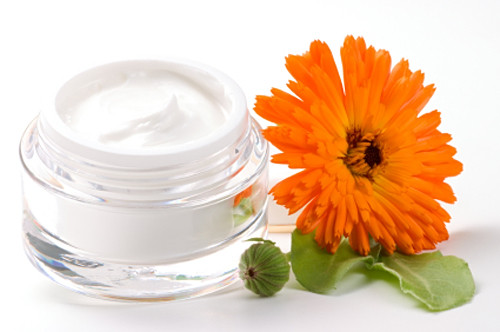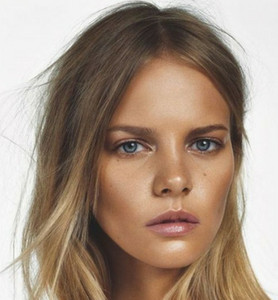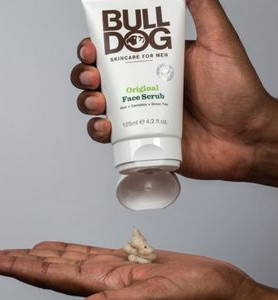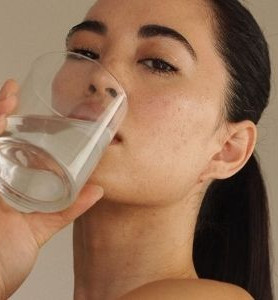Beauty Truths: Some Scary Facts About The Beauty Industry
Words by Buffy Gill of Be Good Organics.
Just over a year and a half ago I got diagnosed with Graves disease. Graves is an autoimmune disease, where the immune system attacks itself and causes the thyroid gland (a small butterfly shaped organ in front of your throat) to enlarge and become overactive, or "hyperthyroid". It's also an endocrine/hormonal disease, as the thyroid controls the hormonal system (hard to imagine given it's up by your throat).
The thyroid is the pace maker of the body, so an overactive thyroid means everything goes into speed overload. My resting heart rate increased from its normal 50-60 (I was pretty fit) to close to 100. Walking up a small hill would quickly push that closer to 200. I had terrible insomnia, body sweats, hand shakes, greater than usual anxiety and irritability, overactivity in the nether regions, and a bulging eye (google some pics if you will). I also lost a lot of weight (BMI below 18), and my reproductive and hormonal system completely shut up shop.
I embarked on a course of treatment with antithyroid medication, but the prognosis was always that most cases can't be cured and need to eventually have radioactive therapy (like a type of chemotherapy), to kill the overactive thryoid off. Alternatively I could get my thryoid cut out, which results in a rather ominous looking long horizontal scar right across your throat. This effectively gives you hypothyroidism, so you have to take another drug for the rest of your life to recreate the function of the destroyed thyroid. Hypothyroidism has a host of other problems associated with it. Not to mention that removing the thyroid doesn't do anything to address the underlying imbalances in the first place.
Now hang on a second? I was in my 20's. I was healthy and fit. There was no genetic history of the disease in my family. The old 'random chance' argument tossed at me by my specialists just didn't seem to ring true. I embarked on the Western medicine course of treatment as instructed, but also went about my own research as to why this could have happened to me. What I found was pretty astounding.
One aspect that I learnt was that organic healthy plant-based foods have the ability to heal, while conventional processed animal-heavy foods have the power to harm. That a toxic and stressful emotional environment (aka my job) was a key trigger for a number of diseases including autoimmune and cancer. And lastly, that there were hundreds of toxic chemicals in my skin care, make-up, body lotion, body wash, haircare, perfume, and household cleaning products.
Today I want to share with you some important discoveries I made about our everyday skin care and beauty products, so you can avoid them too.
SCARY FACTS ABOUT THE BEAUTY INDUSTRY
Here's some scary facts about the personal care and beauty industry. These differ slightly between countries, but the general approach holds true:
1. Almost any chemical can be used as an ingredient in personal care products
2. Labels are allowed to be misleading and incomplete - companies don't have to list all their ingredients
3. Unsubstantiated claims about product benefits are completely allowed
4. There is almost no required safety testing of products or ingredients - less than 20% of ingredients have actually been assessed
5. The average woman uses 12 products per day containing over 168 ingredients (absorbing ~2kg of chemicals a year); a man goes through 6 products with 85 ingredients; a child is exposed to 5 products with 61 ingredients; whilst a teenage girl (hello autoimmune disease) is exposed to a whopping 17 products with over 230 ingredients every day. Most of which are untested safety-unproven chemicals.
6. Products commonly contain penetration enhancers to drive ingredients deeper into the skin - that mean more chemicals absorbed into your blood stream.
7. These chemicals have been scientifically proven to be linked to cancer, endocrine/hormonal disease (alarm bells),thyroid function disruption (more alarm bells), learning disabilities, ashthma, respiratory disease, skin disease, liver damage, brain damage and development problems, immune system damage, male and female reproductive hormone disfunction, damaged sperm, and fetal development issues.
You're kidding me right? Surely our governments would be onto this stuff? Unfortunately the clout of large pharmaceutical and beauty companies, who have a heck of a lot to gain from the industry (and equally as much to lose), use their bargaining power and bulging wallets to make sure safety regulations banning these practices aren't ever passed. Don't mess with Mr Procter or Mr Gamble now.
MISLEADING LABELING
Watch out for labels that say "natural" or "organic". There are currently no regulations in place governing the use of these terms, which means a product can contain only 1% organic ingredients and 99% chemicals, but slap "organic" on the label.
The same goes for products labelled "paraben free", "ammonia free", "sulfate free". They're usually from big companies who've succumbed to the public becoming aware of the dangers of a certain ingredient. So they remove that particular substance, leave the rest of the chemicals in there, and slap a "xxx-free" label on the front alongside some pretty pictures of flowers and rolling fields. It's called "Greenwashing".
Even certification doesn't always guarantee safety - products certified as organic can contain as little as 10% organic ingredients, depending on the certification body and type.
Learn to be a stealth label reader and always turn a product around to see what ingredients are in it. If you can't recognize them, it's probably a good sign to ditch it. Alternatively, source your products from someone you trust, who's done the research for you, and has your best interests at heart (me!).
NASTIES TO AVOID
Here are some key ingredients to avoid: Parabens (propyl, isopropyl, butyl, isobutyl), Formaldehyde, Toluene, DBP (dibutyl phthalate), PEG, Ceteareth, Polyethylene, Petrochemicals, DMDM Hydantoin, Triclosan, Retinyl Palmitate or Retinol, and Oxybenzone. This is merely an entree into the lengthy list of chemicals we're exposed to.
Also avoid anything with "Fragrance/Parfum", unless you've researched exactly what's in it. This is a catch all term many companies use, that can include over 3000 undisclosed chemicals.
If you're not sure about an ingredient, visit the Environmental Working Group's Skin Deep Cosmetics Database. You can enter any ingredient, as well as a number of brands, companies and products, and find out the hazard rating.
TWO ORGANIC RANGES I’M LOVING RIGHT NOW
So what can I use I hear you say? Luckily there are a growing number of companies out there who truly care about this topic, and are doing their ethical darnedest to create skin care ranges for both men and women, that are truly natural and organic, kind to the environment, aren't tested on animals, and actually work. Once you make the switch, you'll suddenly realise that that stinging sensation you used to get from your "serum" was not normal!
Two organic ranges that I am loving right now are Annmarie Gianni, and Sally B's Skin Yummies. Both companies are family owned and operated, adhere to the strictest of environmental, ethical and quality principles, and create products which are both beautiful to use, but are also truly nourishing to your body. They also come highly recommended by a number of key public figures in the organic health and beauty sphere, including Kris Carr, Jess Ainscough from The Wellness Warrior, and Kimberly Snyder. I've personally used both of them and would highly recommend. If you'd like to learn more about the ranges click here.
 SCARY FACTS ABOUT THE BEAUTY INDUSTRY
Here's some scary facts about the personal care and beauty industry. These differ slightly between countries, but the general approach holds true:
1. Almost any chemical can be used as an ingredient in personal care products
2. Labels are allowed to be misleading and incomplete - companies don't have to list all their ingredients
3. Unsubstantiated claims about product benefits are completely allowed
4. There is almost no required safety testing of products or ingredients - less than 20% of ingredients have actually been assessed
5. The average woman uses 12 products per day containing over 168 ingredients (absorbing ~2kg of chemicals a year); a man goes through 6 products with 85 ingredients; a child is exposed to 5 products with 61 ingredients; whilst a teenage girl (hello autoimmune disease) is exposed to a whopping 17 products with over 230 ingredients every day. Most of which are untested safety-unproven chemicals.
6. Products commonly contain penetration enhancers to drive ingredients deeper into the skin - that mean more chemicals absorbed into your blood stream.
7. These chemicals have been scientifically proven to be linked to cancer, endocrine/hormonal disease (alarm bells),thyroid function disruption (more alarm bells), learning disabilities, ashthma, respiratory disease, skin disease, liver damage, brain damage and development problems, immune system damage, male and female reproductive hormone disfunction, damaged sperm, and fetal development issues.
You're kidding me right? Surely our governments would be onto this stuff? Unfortunately the clout of large pharmaceutical and beauty companies, who have a heck of a lot to gain from the industry (and equally as much to lose), use their bargaining power and bulging wallets to make sure safety regulations banning these practices aren't ever passed. Don't mess with Mr Procter or Mr Gamble now.
MISLEADING LABELING
Watch out for labels that say "natural" or "organic". There are currently no regulations in place governing the use of these terms, which means a product can contain only 1% organic ingredients and 99% chemicals, but slap "organic" on the label.
The same goes for products labelled "paraben free", "ammonia free", "sulfate free". They're usually from big companies who've succumbed to the public becoming aware of the dangers of a certain ingredient. So they remove that particular substance, leave the rest of the chemicals in there, and slap a "xxx-free" label on the front alongside some pretty pictures of flowers and rolling fields. It's called "Greenwashing".
Even certification doesn't always guarantee safety - products certified as organic can contain as little as 10% organic ingredients, depending on the certification body and type.
Learn to be a stealth label reader and always turn a product around to see what ingredients are in it. If you can't recognize them, it's probably a good sign to ditch it. Alternatively, source your products from someone you trust, who's done the research for you, and has your best interests at heart (me!).
NASTIES TO AVOID
Here are some key ingredients to avoid: Parabens (propyl, isopropyl, butyl, isobutyl), Formaldehyde, Toluene, DBP (dibutyl phthalate), PEG, Ceteareth, Polyethylene, Petrochemicals, DMDM Hydantoin, Triclosan, Retinyl Palmitate or Retinol, and Oxybenzone. This is merely an entree into the lengthy list of chemicals we're exposed to.
Also avoid anything with "Fragrance/Parfum", unless you've researched exactly what's in it. This is a catch all term many companies use, that can include over 3000 undisclosed chemicals.
If you're not sure about an ingredient, visit the Environmental Working Group's Skin Deep Cosmetics Database. You can enter any ingredient, as well as a number of brands, companies and products, and find out the hazard rating.
TWO ORGANIC RANGES I’M LOVING RIGHT NOW
So what can I use I hear you say? Luckily there are a growing number of companies out there who truly care about this topic, and are doing their ethical darnedest to create skin care ranges for both men and women, that are truly natural and organic, kind to the environment, aren't tested on animals, and actually work. Once you make the switch, you'll suddenly realise that that stinging sensation you used to get from your "serum" was not normal!
Two organic ranges that I am loving right now are Annmarie Gianni, and Sally B's Skin Yummies. Both companies are family owned and operated, adhere to the strictest of environmental, ethical and quality principles, and create products which are both beautiful to use, but are also truly nourishing to your body. They also come highly recommended by a number of key public figures in the organic health and beauty sphere, including Kris Carr, Jess Ainscough from The Wellness Warrior, and Kimberly Snyder. I've personally used both of them and would highly recommend. If you'd like to learn more about the ranges click here.
SCARY FACTS ABOUT THE BEAUTY INDUSTRY
Here's some scary facts about the personal care and beauty industry. These differ slightly between countries, but the general approach holds true:
1. Almost any chemical can be used as an ingredient in personal care products
2. Labels are allowed to be misleading and incomplete - companies don't have to list all their ingredients
3. Unsubstantiated claims about product benefits are completely allowed
4. There is almost no required safety testing of products or ingredients - less than 20% of ingredients have actually been assessed
5. The average woman uses 12 products per day containing over 168 ingredients (absorbing ~2kg of chemicals a year); a man goes through 6 products with 85 ingredients; a child is exposed to 5 products with 61 ingredients; whilst a teenage girl (hello autoimmune disease) is exposed to a whopping 17 products with over 230 ingredients every day. Most of which are untested safety-unproven chemicals.
6. Products commonly contain penetration enhancers to drive ingredients deeper into the skin - that mean more chemicals absorbed into your blood stream.
7. These chemicals have been scientifically proven to be linked to cancer, endocrine/hormonal disease (alarm bells),thyroid function disruption (more alarm bells), learning disabilities, ashthma, respiratory disease, skin disease, liver damage, brain damage and development problems, immune system damage, male and female reproductive hormone disfunction, damaged sperm, and fetal development issues.
You're kidding me right? Surely our governments would be onto this stuff? Unfortunately the clout of large pharmaceutical and beauty companies, who have a heck of a lot to gain from the industry (and equally as much to lose), use their bargaining power and bulging wallets to make sure safety regulations banning these practices aren't ever passed. Don't mess with Mr Procter or Mr Gamble now.
MISLEADING LABELING
Watch out for labels that say "natural" or "organic". There are currently no regulations in place governing the use of these terms, which means a product can contain only 1% organic ingredients and 99% chemicals, but slap "organic" on the label.
The same goes for products labelled "paraben free", "ammonia free", "sulfate free". They're usually from big companies who've succumbed to the public becoming aware of the dangers of a certain ingredient. So they remove that particular substance, leave the rest of the chemicals in there, and slap a "xxx-free" label on the front alongside some pretty pictures of flowers and rolling fields. It's called "Greenwashing".
Even certification doesn't always guarantee safety - products certified as organic can contain as little as 10% organic ingredients, depending on the certification body and type.
Learn to be a stealth label reader and always turn a product around to see what ingredients are in it. If you can't recognize them, it's probably a good sign to ditch it. Alternatively, source your products from someone you trust, who's done the research for you, and has your best interests at heart (me!).
NASTIES TO AVOID
Here are some key ingredients to avoid: Parabens (propyl, isopropyl, butyl, isobutyl), Formaldehyde, Toluene, DBP (dibutyl phthalate), PEG, Ceteareth, Polyethylene, Petrochemicals, DMDM Hydantoin, Triclosan, Retinyl Palmitate or Retinol, and Oxybenzone. This is merely an entree into the lengthy list of chemicals we're exposed to.
Also avoid anything with "Fragrance/Parfum", unless you've researched exactly what's in it. This is a catch all term many companies use, that can include over 3000 undisclosed chemicals.
If you're not sure about an ingredient, visit the Environmental Working Group's Skin Deep Cosmetics Database. You can enter any ingredient, as well as a number of brands, companies and products, and find out the hazard rating.
TWO ORGANIC RANGES I’M LOVING RIGHT NOW
So what can I use I hear you say? Luckily there are a growing number of companies out there who truly care about this topic, and are doing their ethical darnedest to create skin care ranges for both men and women, that are truly natural and organic, kind to the environment, aren't tested on animals, and actually work. Once you make the switch, you'll suddenly realise that that stinging sensation you used to get from your "serum" was not normal!
Two organic ranges that I am loving right now are Annmarie Gianni, and Sally B's Skin Yummies. Both companies are family owned and operated, adhere to the strictest of environmental, ethical and quality principles, and create products which are both beautiful to use, but are also truly nourishing to your body. They also come highly recommended by a number of key public figures in the organic health and beauty sphere, including Kris Carr, Jess Ainscough from The Wellness Warrior, and Kimberly Snyder. I've personally used both of them and would highly recommend. If you'd like to learn more about the ranges click here.
 For more information on beauty, health and wellbeing and to buy all the above products, visit Buffy's blog post on Be Good Organics here. Also make sure you follow Be Good Organics on Facebook, Twitter and Instagram to stay up to date with the latest dietary, beauty and lifestyle tips.
For more information on beauty, health and wellbeing and to buy all the above products, visit Buffy's blog post on Be Good Organics here. Also make sure you follow Be Good Organics on Facebook, Twitter and Instagram to stay up to date with the latest dietary, beauty and lifestyle tips.
 SCARY FACTS ABOUT THE BEAUTY INDUSTRY
Here's some scary facts about the personal care and beauty industry. These differ slightly between countries, but the general approach holds true:
1. Almost any chemical can be used as an ingredient in personal care products
2. Labels are allowed to be misleading and incomplete - companies don't have to list all their ingredients
3. Unsubstantiated claims about product benefits are completely allowed
4. There is almost no required safety testing of products or ingredients - less than 20% of ingredients have actually been assessed
5. The average woman uses 12 products per day containing over 168 ingredients (absorbing ~2kg of chemicals a year); a man goes through 6 products with 85 ingredients; a child is exposed to 5 products with 61 ingredients; whilst a teenage girl (hello autoimmune disease) is exposed to a whopping 17 products with over 230 ingredients every day. Most of which are untested safety-unproven chemicals.
6. Products commonly contain penetration enhancers to drive ingredients deeper into the skin - that mean more chemicals absorbed into your blood stream.
7. These chemicals have been scientifically proven to be linked to cancer, endocrine/hormonal disease (alarm bells),thyroid function disruption (more alarm bells), learning disabilities, ashthma, respiratory disease, skin disease, liver damage, brain damage and development problems, immune system damage, male and female reproductive hormone disfunction, damaged sperm, and fetal development issues.
You're kidding me right? Surely our governments would be onto this stuff? Unfortunately the clout of large pharmaceutical and beauty companies, who have a heck of a lot to gain from the industry (and equally as much to lose), use their bargaining power and bulging wallets to make sure safety regulations banning these practices aren't ever passed. Don't mess with Mr Procter or Mr Gamble now.
MISLEADING LABELING
Watch out for labels that say "natural" or "organic". There are currently no regulations in place governing the use of these terms, which means a product can contain only 1% organic ingredients and 99% chemicals, but slap "organic" on the label.
The same goes for products labelled "paraben free", "ammonia free", "sulfate free". They're usually from big companies who've succumbed to the public becoming aware of the dangers of a certain ingredient. So they remove that particular substance, leave the rest of the chemicals in there, and slap a "xxx-free" label on the front alongside some pretty pictures of flowers and rolling fields. It's called "Greenwashing".
Even certification doesn't always guarantee safety - products certified as organic can contain as little as 10% organic ingredients, depending on the certification body and type.
Learn to be a stealth label reader and always turn a product around to see what ingredients are in it. If you can't recognize them, it's probably a good sign to ditch it. Alternatively, source your products from someone you trust, who's done the research for you, and has your best interests at heart (me!).
NASTIES TO AVOID
Here are some key ingredients to avoid: Parabens (propyl, isopropyl, butyl, isobutyl), Formaldehyde, Toluene, DBP (dibutyl phthalate), PEG, Ceteareth, Polyethylene, Petrochemicals, DMDM Hydantoin, Triclosan, Retinyl Palmitate or Retinol, and Oxybenzone. This is merely an entree into the lengthy list of chemicals we're exposed to.
Also avoid anything with "Fragrance/Parfum", unless you've researched exactly what's in it. This is a catch all term many companies use, that can include over 3000 undisclosed chemicals.
If you're not sure about an ingredient, visit the Environmental Working Group's Skin Deep Cosmetics Database. You can enter any ingredient, as well as a number of brands, companies and products, and find out the hazard rating.
TWO ORGANIC RANGES I’M LOVING RIGHT NOW
So what can I use I hear you say? Luckily there are a growing number of companies out there who truly care about this topic, and are doing their ethical darnedest to create skin care ranges for both men and women, that are truly natural and organic, kind to the environment, aren't tested on animals, and actually work. Once you make the switch, you'll suddenly realise that that stinging sensation you used to get from your "serum" was not normal!
Two organic ranges that I am loving right now are Annmarie Gianni, and Sally B's Skin Yummies. Both companies are family owned and operated, adhere to the strictest of environmental, ethical and quality principles, and create products which are both beautiful to use, but are also truly nourishing to your body. They also come highly recommended by a number of key public figures in the organic health and beauty sphere, including Kris Carr, Jess Ainscough from The Wellness Warrior, and Kimberly Snyder. I've personally used both of them and would highly recommend. If you'd like to learn more about the ranges click here.
SCARY FACTS ABOUT THE BEAUTY INDUSTRY
Here's some scary facts about the personal care and beauty industry. These differ slightly between countries, but the general approach holds true:
1. Almost any chemical can be used as an ingredient in personal care products
2. Labels are allowed to be misleading and incomplete - companies don't have to list all their ingredients
3. Unsubstantiated claims about product benefits are completely allowed
4. There is almost no required safety testing of products or ingredients - less than 20% of ingredients have actually been assessed
5. The average woman uses 12 products per day containing over 168 ingredients (absorbing ~2kg of chemicals a year); a man goes through 6 products with 85 ingredients; a child is exposed to 5 products with 61 ingredients; whilst a teenage girl (hello autoimmune disease) is exposed to a whopping 17 products with over 230 ingredients every day. Most of which are untested safety-unproven chemicals.
6. Products commonly contain penetration enhancers to drive ingredients deeper into the skin - that mean more chemicals absorbed into your blood stream.
7. These chemicals have been scientifically proven to be linked to cancer, endocrine/hormonal disease (alarm bells),thyroid function disruption (more alarm bells), learning disabilities, ashthma, respiratory disease, skin disease, liver damage, brain damage and development problems, immune system damage, male and female reproductive hormone disfunction, damaged sperm, and fetal development issues.
You're kidding me right? Surely our governments would be onto this stuff? Unfortunately the clout of large pharmaceutical and beauty companies, who have a heck of a lot to gain from the industry (and equally as much to lose), use their bargaining power and bulging wallets to make sure safety regulations banning these practices aren't ever passed. Don't mess with Mr Procter or Mr Gamble now.
MISLEADING LABELING
Watch out for labels that say "natural" or "organic". There are currently no regulations in place governing the use of these terms, which means a product can contain only 1% organic ingredients and 99% chemicals, but slap "organic" on the label.
The same goes for products labelled "paraben free", "ammonia free", "sulfate free". They're usually from big companies who've succumbed to the public becoming aware of the dangers of a certain ingredient. So they remove that particular substance, leave the rest of the chemicals in there, and slap a "xxx-free" label on the front alongside some pretty pictures of flowers and rolling fields. It's called "Greenwashing".
Even certification doesn't always guarantee safety - products certified as organic can contain as little as 10% organic ingredients, depending on the certification body and type.
Learn to be a stealth label reader and always turn a product around to see what ingredients are in it. If you can't recognize them, it's probably a good sign to ditch it. Alternatively, source your products from someone you trust, who's done the research for you, and has your best interests at heart (me!).
NASTIES TO AVOID
Here are some key ingredients to avoid: Parabens (propyl, isopropyl, butyl, isobutyl), Formaldehyde, Toluene, DBP (dibutyl phthalate), PEG, Ceteareth, Polyethylene, Petrochemicals, DMDM Hydantoin, Triclosan, Retinyl Palmitate or Retinol, and Oxybenzone. This is merely an entree into the lengthy list of chemicals we're exposed to.
Also avoid anything with "Fragrance/Parfum", unless you've researched exactly what's in it. This is a catch all term many companies use, that can include over 3000 undisclosed chemicals.
If you're not sure about an ingredient, visit the Environmental Working Group's Skin Deep Cosmetics Database. You can enter any ingredient, as well as a number of brands, companies and products, and find out the hazard rating.
TWO ORGANIC RANGES I’M LOVING RIGHT NOW
So what can I use I hear you say? Luckily there are a growing number of companies out there who truly care about this topic, and are doing their ethical darnedest to create skin care ranges for both men and women, that are truly natural and organic, kind to the environment, aren't tested on animals, and actually work. Once you make the switch, you'll suddenly realise that that stinging sensation you used to get from your "serum" was not normal!
Two organic ranges that I am loving right now are Annmarie Gianni, and Sally B's Skin Yummies. Both companies are family owned and operated, adhere to the strictest of environmental, ethical and quality principles, and create products which are both beautiful to use, but are also truly nourishing to your body. They also come highly recommended by a number of key public figures in the organic health and beauty sphere, including Kris Carr, Jess Ainscough from The Wellness Warrior, and Kimberly Snyder. I've personally used both of them and would highly recommend. If you'd like to learn more about the ranges click here.
 For more information on beauty, health and wellbeing and to buy all the above products, visit Buffy's blog post on Be Good Organics here. Also make sure you follow Be Good Organics on Facebook, Twitter and Instagram to stay up to date with the latest dietary, beauty and lifestyle tips.
For more information on beauty, health and wellbeing and to buy all the above products, visit Buffy's blog post on Be Good Organics here. Also make sure you follow Be Good Organics on Facebook, Twitter and Instagram to stay up to date with the latest dietary, beauty and lifestyle tips.





